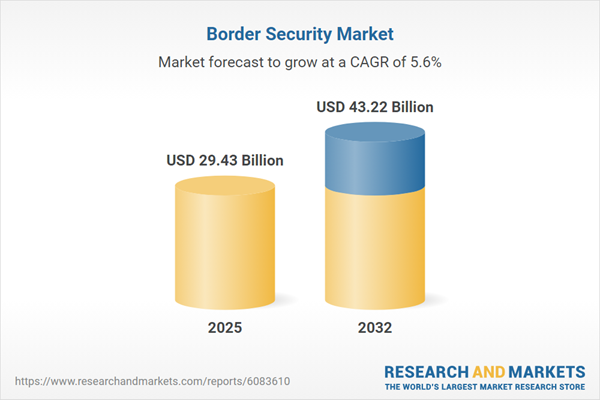Speak directly to the analyst to clarify any post sales queries you may have.
The border security market is undergoing rapid transformation as governments and key industry stakeholders prioritize integrated solutions that address an expanding spectrum of operational, technological, and geopolitical challenges. Senior decision-makers now require actionable market intelligence that aligns with evolving threat landscapes and organizational mandates.
Market Snapshot: Border Security Market Growth and Outlook
The Border Security Market grew from USD 27.89 billion in 2024 to USD 29.43 billion in 2025. It is expected to continue growing at a CAGR of 5.62%, reaching USD 43.22 billion by 2032. Market expansion is powered by advances in sensors, artificial intelligence, and unmanned platforms, combined with new regulatory imperatives and increased public-private collaboration. These shifts drive investments in innovative systems designed for improved border integrity, cross-border cooperation, and cost efficiency.
Scope & Segmentation: Comprehensive Coverage Across Products, Technologies, Applications, and Regions
- Product Types: Biometrics (facial, fingerprint, and iris recognition), border barriers, communication systems, detection systems (biological, chemical, radiation), surveillance (radar, thermal imaging, unmanned aerial surveillance, video monitoring).
- Technologies: Radar (ground-based, over-the-horizon), radio frequency identification, sensor fusion, thermal imaging, video analytics for behavior analysis and object detection.
- Applications: Air border security, critical infrastructure protection, land border surveillance, maritime border monitoring including coastal and port security.
- End Users: Customs and immigration, government agencies, law enforcement, military forces.
- Deployment Modes: Mobile (UAV and vehicle-mounted), portable kits, stationary installations.
- Regional Coverage: Americas (North America: United States, Canada, Mexico; Latin America: Brazil, Argentina, Chile, Colombia, Peru), Europe, Middle East & Africa (Europe: United Kingdom, Germany, France, Russia, Italy, Spain, Netherlands, Sweden, Poland, Switzerland; Middle East: United Arab Emirates, Saudi Arabia, Qatar, Turkey, Israel; Africa: South Africa, Nigeria, Egypt, Kenya), Asia-Pacific (China, India, Japan, Australia, South Korea, Indonesia, Thailand, Malaysia, Singapore, Taiwan).
- Key Companies: Thales S.A., Leonardo S.p.A., Lockheed Martin Corporation, Raytheon Technologies Corporation, Airbus SE, Northrop Grumman Corporation, L3Harris Technologies, Inc., Safran S.A., BAE Systems plc, Elbit Systems Ltd.
Key Takeaways: Strategic Insights for Senior Decision-Makers
- Integrated sensor and AI-driven systems are redefining border operations, enabling predictive analytics and rapid threat response.
- Technology adoption is moving towards modular, scalable solutions that support both physical and cyber resilience, while facilitating interoperability among agencies.
- Strategic shifts in procurement prioritize localized supply chains and flexible vendor portfolios to address tariff risks and ensure mission continuity.
- Cross-sector partnerships accelerate innovation, particularly in biometric gateways, autonomous surveillance, and cloud-native command platforms.
- End-user requirements drive product customization, with varying operational tempos, regulatory standards, and environmental considerations influencing system design.
Tariff Impact: 2025 US Measures and Border Security Supply Chains
New US tariff measures in 2025 have influenced border security procurement through increased hardware and software costs. Organizations are responding by shifting sourcing to mitigate import duties, leveraging nearshoring, and renegotiating with domestic suppliers. System integrators balance component substitution with the need to uphold interoperability and reliability standards, driving rigorous lifecycle management and supplier validation.
Methodology & Data Sources
This report employs a multi-tier research process, combining open-source literature review, quantitative data from primary stakeholders, and expert panel validation. Scenario-based modeling and cross-comparison of case studies reinforce the accuracy and neutrality of findings.
Why This Report Matters: Benefits for Executives
- Gain robust visibility into emerging trends, business models, and operational practices reshaping the border security landscape.
- Make informed investment and sourcing decisions using a detailed segmentation and vendor analysis encompassing critical technologies, regions, and user needs.
- Adapt strategies proactively to address changing regulatory, geopolitical, and technological drivers that shape border security priorities worldwide.
Conclusion
Border security is evolving toward connected, adaptive frameworks that integrate technology, policy, and operational expertise. Leaders prepared to leverage these insights will optimize defense strategies, enhance efficiency, and advance national objectives in a complex security environment.
Table of Contents
3. Executive Summary
4. Market Overview
7. Cumulative Impact of Artificial Intelligence 2025
Companies Mentioned
The companies profiled in this Border Security market report include:- Thales S.A.
- Leonardo S.p.A.
- Lockheed Martin Corporation
- Raytheon Technologies Corporation
- Airbus SE
- Northrop Grumman Corporation
- L3Harris Technologies, Inc.
- Safran S.A.
- BAE Systems plc
- Elbit Systems Ltd.
Table Information
| Report Attribute | Details |
|---|---|
| No. of Pages | 188 |
| Published | October 2025 |
| Forecast Period | 2025 - 2032 |
| Estimated Market Value ( USD | $ 29.43 Billion |
| Forecasted Market Value ( USD | $ 43.22 Billion |
| Compound Annual Growth Rate | 5.6% |
| Regions Covered | Global |
| No. of Companies Mentioned | 11 |









